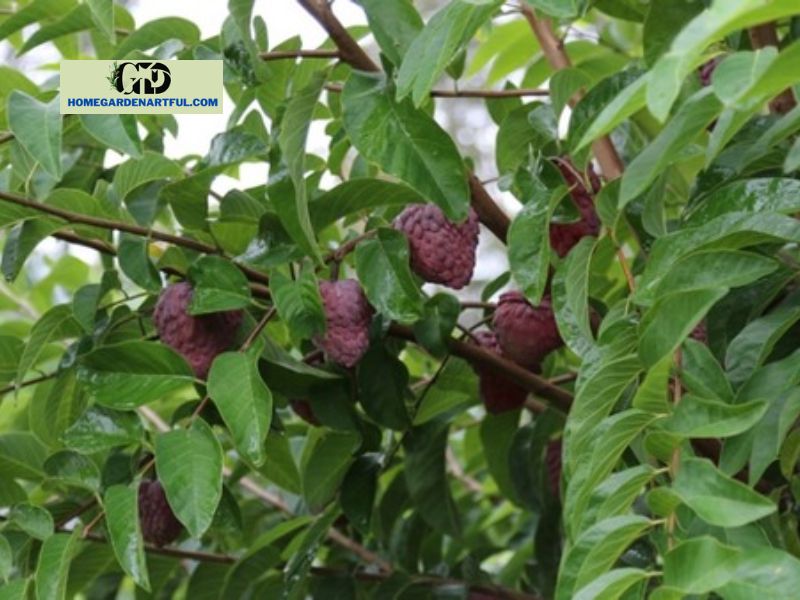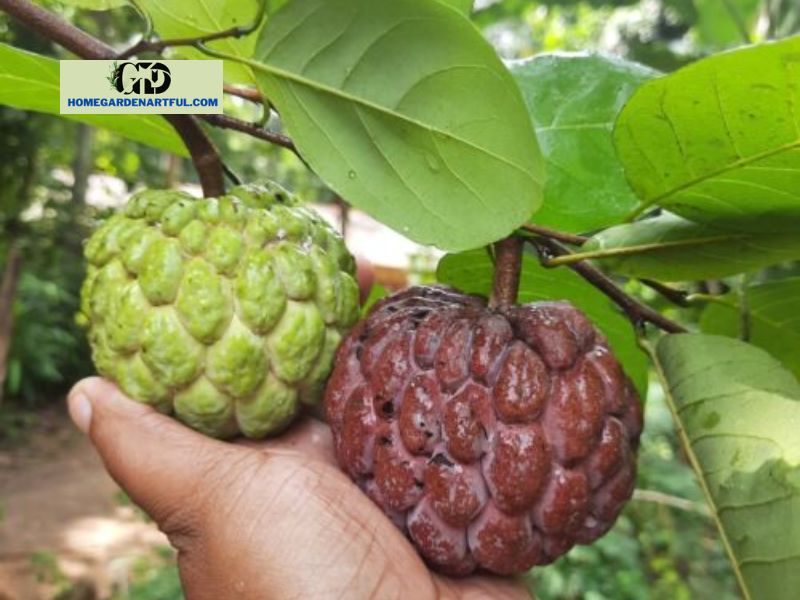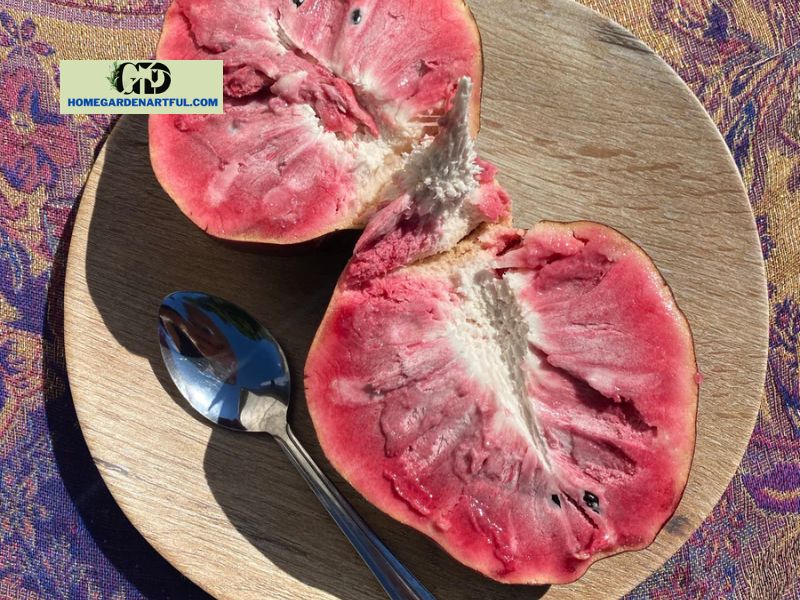You can enjoy wonderful fruits from the Red Custard Apple Tree fresh or use them in a variety of ways. Here’s how you can quickly cultivate it at home!
Grow Red Custard apples for a delicious tropical treat if you want to make your sweets, smoothies, and fruit salads taste better! Discover at homegardenartful.com!
Information about Red Custard Apple Trees

Red Custard Apple is officially known as Annona reticulata. It is a member of the family Annonaceae, which also includes a number of other tropical fruit trees.
The Red Custard Apple is a native of the tropics of the Americas, especially the Caribbean and Central America. Other tropical and subtropical areas of the world, such as Southeast Asia and parts of Africa, have seen its cultivation and naturalization.
Red Custard Apples often have round or heart-shaped fruit, thus the common name “Bullock’s Heart.” When ripe, the thin, reticulated skin turns reddish-brown or reddish-yellow. The flesh’s inside is creamy, white to pale yellow, and has a sweet, custard-like flavor. Numerous shiny, black seeds that are typically inedible are present in the fruit.
A deciduous tree, the Red Custard Apple tree can reach heights of 15 to 35 feet. It can produce fragrant flowers and has broad, glossy green leaves. The environment should be tropical or subtropical, the soil should drain quickly, and the tree only needs occasional watering.
Red Custard Apples are often eaten fresh, and a spoon can be used to remove the sweet, creamy flesh. Fruit salads, smoothies, and desserts can all benefit from its addition. It is a lovely tropical delicacy due to its distinctive flavor and texture.
Red Custard Apple Tree Propagation

Techniques Red Custard Apple Propagation Techniques:
- Air layering, grafting, and seed propagation
- The simplest and most popular way to multiply Red Custard Apples is by seed. Here is how to go about it:
- Obtain the seeds from a Red Custard Apple that is ripe and healthy. Pick fruit from a tree that is renowned for producing high-quality fruit.
- Fruit pulp should be thoroughly removed from the seeds because it can promote fungal growth.
- To help soften the seed coat, soak the seeds in water for a day.
- Prepare a planting container with an organically rich, well-draining soil mixture.
- In the dirt, sow the seeds approximately an inch deep.
- Water the soil thoroughly, making sure it’s moist but not drenched.
- Avoid direct sunlight and place the container in a warm, well-lit location.
- Depending on the environment and the freshness of the seeds, germination often takes a few weeks.
Pro Tip: Purchasing a well-grafted tree from a garden center will be a terrific option. Compared to seed-grown trees, grafted plants typically produce fruit sooner. You might choose a specific cultivar that has a history of producing fruit.
Ideal size for a red custard apple tree in a pot
Start with a pot with a diameter and depth of around 8 to 10 inches. The young plant will have ample room to spread its roots in this manner.
You’ll need to progressively raise the container size as the tree grows. For the following three to four years, a pot with a diameter and depth of roughly 12 to 16 inches should be adequate.
Requirements for Red Custard Apple Tree Growth

Light
For optimum growth and fruiting, the Red Custard Apple Tree requires at least 6-7 hours per day of direct sunlight exposure. It thrives in full light.
Place the tree facing south or southeast to capture enough sunshine throughout the day for optimum growth.
Soil
Use drained soil that has been improved with coarse sand, compost, and perlite or vermiculite. About 60–70% garden soil, 20–30% compost, and 10–20% perlite/vermiculite as well as coarse sand can be found in a balanced soil mixture.
For optimal nutritional absorption, keep the pH level between 6.5 and 7.5, which ranges from slightly acidic to neutral.
Water
Always monitor the soil moisture before watering. About an inch of earth should be touched with your finger. Water is needed if the soil seems dry. Wait a day or two until checking again if it feels damp.
Aim the water at the plant’s base, close to the soil line, and stay away from the foliage because damp leaves can cause fungal illnesses.
Thermodynamics and Humidity
The Red Custard Apple Tree does best in warm settings with temperatures between 68°F and 90°F (20°C and 34°C), but it is vulnerable to cold temperatures below 50°F (10°C).
The ideal humidity level for the tree is moderate, with a modest increase during growth and flowering. Protection from frost and severe winds is advised, as well as adequate airflow.
Care for Red Custard Apple Trees
Fertilizer
When the Red Custard Apple Tree is actively developing (Spring), apply water-soluble fertilizer for fruit trees as well as a 2-8-8 (NPK) formula every 6 to 8 weeks after diluting it to half of its recommended strength.
After harvesting and during the winter, avoid feeding the plant.
Pruning
The health and shape of the Red Custard Apple Tree depend on proper pruning. Techniques include pruning the tree’s structure, eliminating sick or dead limbs, and thinning dense growth.
Avoid extensive trimming during flowering and fruiting; it is best to do it in the winter dormant season.
Diseases and Pests
Scales, moths, mealy bugs, aphids, and other pests are prone to attack the Red Custard Apple Tree. Fruits are damaged by insects that infest them.
During the early stages of development, covering the Custard apple fruits with materials like paper, plastic bags, or polyethylene is a useful technique. To avoid too much moisture and fruit rot, the bags should completely enclose the fruits, keep open at the base, and contain micro-perforations for water and gas discharge.
The common diseases anthracnose as well as leaf spot, which get stronger during wet spells and stable, warm temperatures, affect the Red Custard apple tree as well.
FAQs
Is it possible to grow red custard apple trees indoors or in containers?
Absolutely! Even though these trees thrive in tropical environments, with the right care, they transfer well to containers and you can still appreciate their tropical beauty in non-tropical areas.
How Can Red Custard Apple Trees Be Encouraged to Produce Flowers and Fruit?
Increase flower and fruit production by making use of balanced fertilizers, guaranteeing sufficient sunlight, engaging in routine trimming, and keeping ideal humidity levels to foster the tree’s reproductive success.
What are Red Custard Apple’s Medicinal Uses?
In traditional medicine, red custard apples are thought to have anti-inflammatory and antioxidant qualities. Before taking into account any medicinal uses, you must, however, speak with a medical expert.


